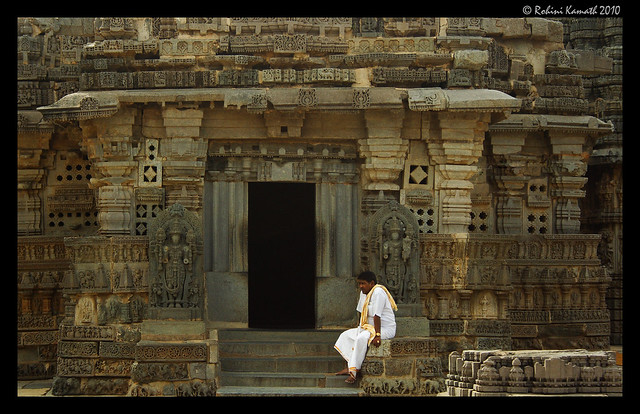
Looking as it might have done 700 years ago, expect for the watch on his wrist
It is the place to go to avoid crowds and still appreciate the wonderful architecture of the Hoysala Dynasty. Being little known and not very publicised, it has fewer visitors than the more popular temples at Belur and Halebidu. It also has much worse roads, sadly, but lets focus on the positives.
The Somnathpur Temple is said to be the finest example of Hoysala Architecture and was built in 1268 under the Hoysala king Narasimha III, it was built (funded) by Somanatha - a Commander in the army. The Town of Somnathpur also gets its name from him. It is built using chloritic chist (Soapstone).
The architect/sculptor was Ruvari Malithamma who has kindly left his signatures for easy id.
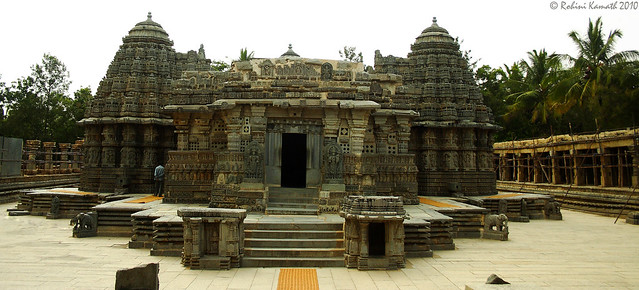
The Front of the East facing temple, inside the compound. I have cloned out a few wires
So what makes it the finest example?
It is among the last of the Hoyasala Temples, and it is also the best preserved ( although some parts and sculptures are damaged - some in war, some by tourist morons ). It is also symmetrical in its design, it has 3 shrines, each of which are equally important, having intricate carvings.
The King Vishnuvardhana was a Vaishnavite (Vishnu worshipper), his wife ShantalaDevi was a devout Jain. He built temples to all the prevalent gods to keep harmony - Jain, Vishnu and Shiva. Narasimha III was his descendant.

The rear of the temple
The layout
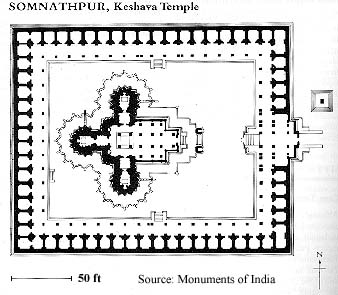
There is a high outer compound that surrounds the temple and a Lamp Pillar on the grounds outside, it could also be a Garuda Stumbha (Column) since it is the mount of Vishnu and this is a Vishnu temple. Once inside there is a lengthy inscription carved in kannada on an enormous tablet that describes the origins of the temple.
There is a covered walk way all around the temple, which is closed and currently held up by steel supports and apparently under restoration. There are huge lathe carved pillars that hold up the structures inside the temple itself.
The inside is a bit dark and hard to photograph, it is illuminated by some tubelights and no effort has been made to conceal the ugly wiring. There are 3 deities inside all are forms of Vishnu. There are no Shivaite statutes here.
What to notice
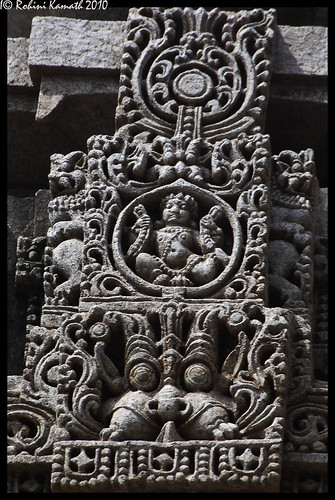
In Monochrome, from the top of the temple, where the vandals couldn't reach it
First off, the Hoysala Standard is the tiger. The name Hoysala is believed to have come from the story of a jain youth named Sala, who fought a tiger ( Hoy - means strike in Ancient Kannada ) to protect his guru. The standard can be seen all over the temple, and in some places has been vandalised, supposedly by soldiers of opposing armies during war.
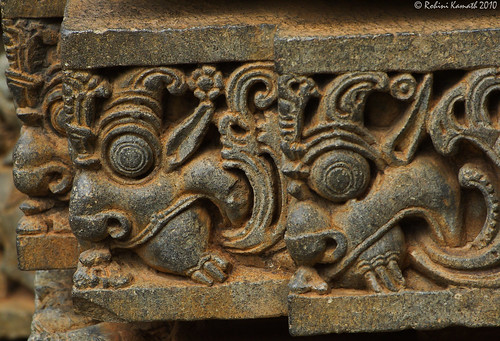
Lakshmi Dancing
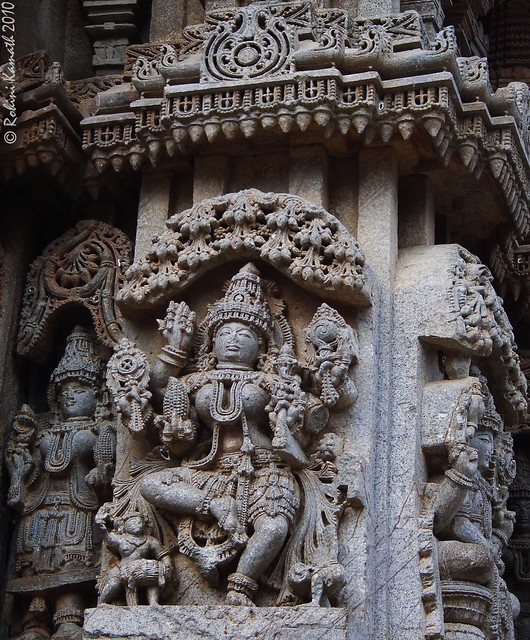
Goddess Lakshmi dancing to the drums
Observe the tiny lady at the bottom beating the drums to which she is dancing. She is holding a fruit in her hand signifying abundance( I thought it was a corn cob, but according to the archaeology site its actually a citron fruit )
The citron is native to india, and its cultivation has declined since the introduction of lemons.
Do follow the link for the history.
Seated Vishnu and Lakshmi
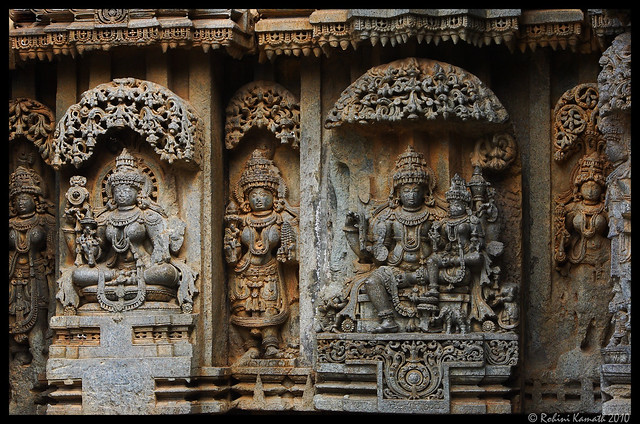
Whats interesting here, is the weight of lakshmi's foot on the lotus is shown causing it to bend over, and an elephant is added to support its weight.
Vishnu and Ganesh
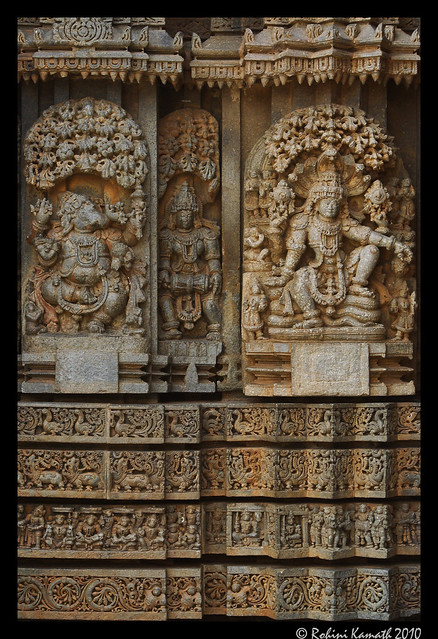
Unusually, the sculptures are all signed (the square plaques). They are Mallithamma, Masanithamma, Chameya, Rameya, Chaudeya, Nanjeya, Pallavachari and Cholavachari.
Wall Friezes
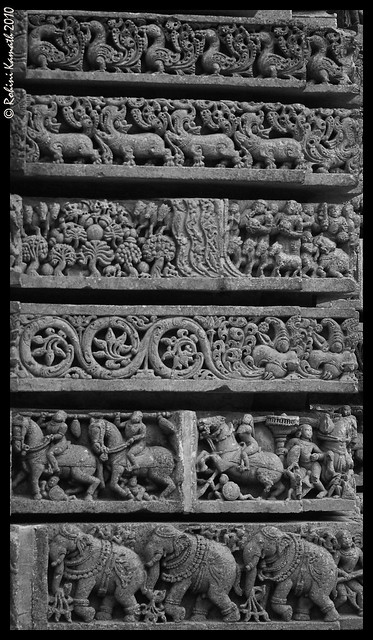
The bottom of the frieze has elephants ( supporting the temple on their backs), signifying stability, next come the riders on the horses, floral patterns along with the hoysala tiger emblem, depictions of stories, a line of mythological beasts - a combination of various animals and finally swans.
The Ramayana is depicted on the friezes on the south side wall, stories of Hindu God Krishna on the rear and the Mahabharata on the north side.
Meditating Vishnu
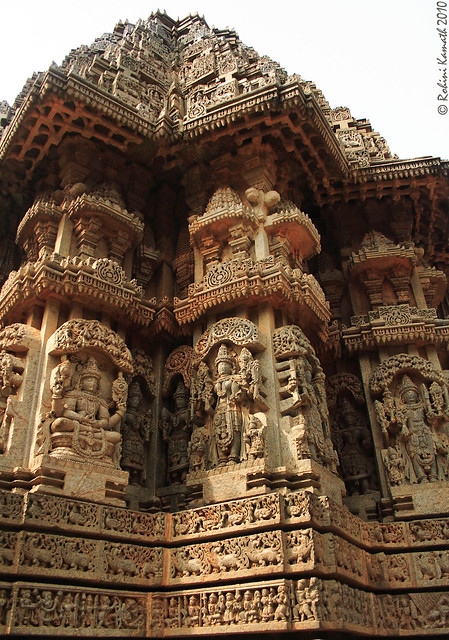
Not usually depicted this way, shows Vishnu seated in a Buddha-like meditation posture.
Indra on the white elephant

Indra with wife SachiDevi on Airawath
Im borrowing this from Keshav's images since my own of this was over exposed.
The elephant is shown with tusks partially filed, as was the practice to prevent them from injuring themselves, riders and keepers. Indra has in his hand the Vajra (thunderbolt weapon).
Wait, Theres More
In addition to these, also do not miss the Krishna with Flute, the statue of Brahma, Saraswati with an unidentified instrument, the Dasha Avatars of Vishnu.
I missed these Im sorry to say, since we got there late and had to rush.
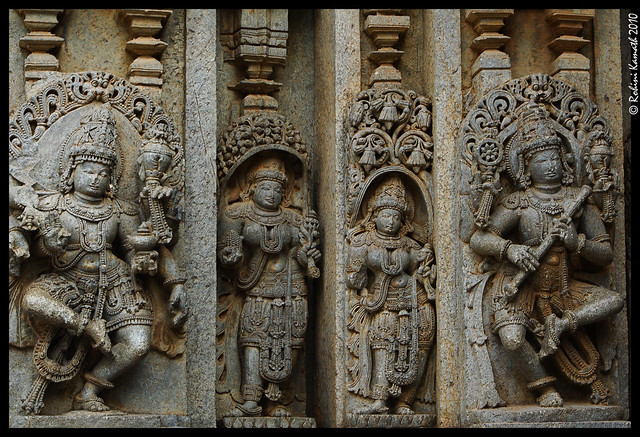
I liked this group, there is no damage to any of them, haven't figured out who they are yet
Getting there
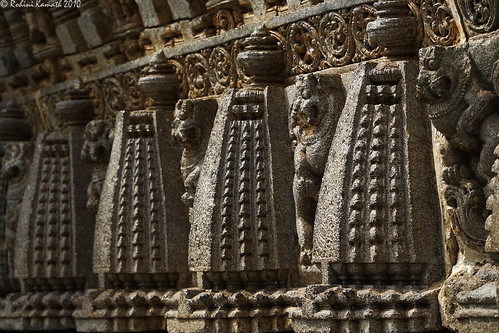
Closeups and more hoysala emblems
It is 180kms from Bangalore. Guide books say "Somanthpur From Bangalore, going along the Bangalore Mysore highway, take the scenic country road from Mandya via Bannur." It is scenic alright, but did you miss "country road" ?
Much of the road looks like excavation in progress by the Archaeological Survey of India. Pot holes are the size of watering holes - you have been warned. In patches the road is excellent, don't give in to the temptation to speed, the bad patches spring up quite suddenly. Seems like no one of importance since King Narsimhan III has visited it since its inception.
For a detailed map pls check Keshav's directions on his blog, you can also see some more of his photos.
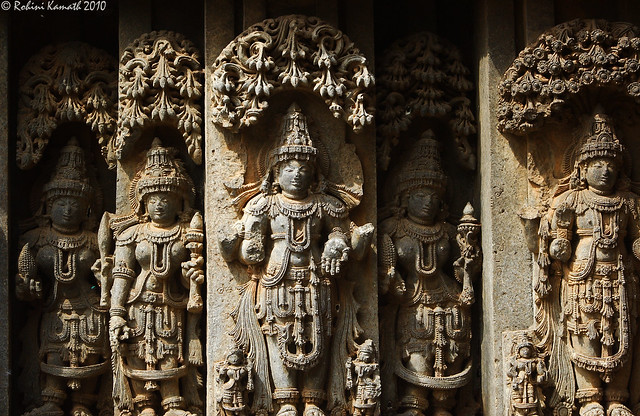
I liked the play of light and shadow here, this group is not identified yet
Tips
Shoes are not allowed in the temple, do wear socks, the stone can get very hot.
Carry a hat, mineral water and snacks are available at the small shops outside the temple.
Parking is scarce be prepared to squeeze into tight spots.
There are no toilets, be prepared to hold it as well :-)
There is a small tea stall, which serves excellent tea in thimble like plastic cups, we must have knocked back a dozen of them.
There are no restaurants nearby. No souvenir shops either.
You need to buy a ticket to get in. Carry loose cash.
We paid the guide 200 bucks to keep out of our hair.
Eat at Kamats on the way, there are 2 now, incase you miss the first.

If you look carefully no two people are alike
Do a little research before you get there, you'll appreciate it more. I did my research afterwards and am sorely repenting. Seeing all of it requires a lot of time, don't rush. The guides will pester you, so finish that off first. Its more fun to figure out which sculptures they are on your own.
Sources:
Wikipedia
Art and Archeology






7 comments:
Wonderful presentation Rohini! You may want to visit Belur and Halebid as well. Another set of architectural marvel by HoysaLas. Classic examples of extreme engineering!
Stunning photos! I have left you something on my blog.
Take care
Neryl.
Great photos. Love them. It is really unusual that there are signed stone plaques. I have not heard of this. Do you know of any other temples where the sculptor has left his signature?
Might be an interesting project to find such ones.
Thanks all.
@Sathish: I think the Hoyasala sculptors would sign their sculptures. I havent seen the other hoysala sites yet, so will confirm on this after that.
Do keep me posted if you know of other such temples.
@Ananth: Belur and Halebidu are very much on my list of must dos. We also tried Hampi (thats another story) - the bad roads really can get to you.
@Sweet Art: Thanks!!! Very honored to see my blog on your list.
Nice work Rohini. The attention you have paid to describing the place is very noteworthy. Speaks a lot of how important the subject is to you. Keep it up.
Thanks neeraj. Comments/compliments/critic is always appreciated.
We're planning a visit to Hampi shortly. You can expect some photos from there as well. Im currently in the research phase and I can safely say that 4 days isnt enough. I think it will need to be done in phases.
nice pics with information thnx a lot
Post a Comment
Please do not post ADs here, they will not be published. All comments are moderated.